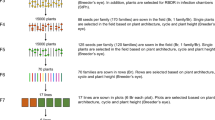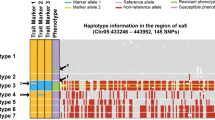Abstract
This article presents selected results of a study carried out in Mexico at the International Maize and Wheat Improvement Center (CIMMYT) to compare the cost-effectiveness of conventional and biotechnology-assisted maize breeding. Costs associated with the use of conventional and marker-assisted selection (MAS) methods at CIMMYT were estimated using a spreadsheet-based budgeting approach. This information was used to compare the costs of conventional and MAS methods for a particular breeding application: introgressing an elite allele at a single dominant gene into an elite maize line (line conversion). At CIMMYT, neither method shows clear superiority in terms of both cost and speed: conventional breeding schemes are less expensive, but MAS-based breeding schemes can be completed in less time. For applications involving tradeoffs between time and money, relative profitability can be evaluated using conventional investment theory. Using a simple model of a plant breeding program, we show that the optimal choice of a breeding technology depends on the availability of operating capital. If operating capital is abundantly available, the "best" breeding method will be the one that maximizes the net present value (i.e., MAS), but if operating capital is constrained, the "best" breeding method will be the one that maximizes the internal rate of return (i.e., conventional selection). This insight may help to explain why private firms tend to invest more aggressively in biotechnology than public breeding programs, which are more likely to face budgetary constraints.
Similar content being viewed by others
References
Beckman J.S. and Soller M. 1983. Restriction fragment length polymorphisms in genetic improvement: methodologies, mapping and costs. Theor. Appl. Genet. 67: 35–43.
Brennan J.P. 1999. An analysis of economic potential of some innovations in a wheat breeding program. Aus. J. Ag. Econ. 33: 48–55.
Crouch J.H. 2000. Molecular marker-assisted breeding: A perspective for small to medium-sized plant breeding companies. In: Conference paper. Asian Seed 2000: Seventh Annual Conference of the Asia & Pacific Seed Association. September 25- 28, Bangalore, India.
Dreher K., Khairallah M., Ribaut J.-M. and Morris M.L. 2003. Money matters (I): Costs of field and laboratory procedures associated with conventional and marker-assisted maize breeding at CIMMYT. Mol. Breed., this issue.
Dreher K., Morris M.L., Ribaut J.-M., Khairallah M., Pandey S. and Srinivasan G. 2000. Is marker-assisted selection cost-effective compared to conventional plant breeding methods? In: The case of Quality Protein Maize. Paper prepared for the Third Annual Conference of the International Consortium for Agricultural Biotechnology Research, August 25- 28, Ravello, Italy.
Frisch M., Bohn M. and Melchinger A.E. 1999a. Minimum sample size and optimal positioning of flanking markers in marker-assisted backcrossing for transfer of a target gene. Crop. Sci. 39: 967–975.
Frisch M., Bohn M. and Melchinger A.E. 1999b. Comparison of selection strategies for marker-assisted backcrossing of a gene. Crop. Sci. 39: 1295–1301.
Gittinger J.P. 1980. Economic Analysis of Agricultural Projects. World Bank, Washington, DC, USA.
Mohan M., Nair S., Bhagwat A., Krishna T.G., Yano M., Bhatia C.R. et al. 1997. Genome mapping, molecular markers and marker-assisted selection in crop plants. Mol. Breed. 3: 87–103.
Pandey S. and Rajatasereekul S. 1999. Economics of plant breeding: The value of shorter breeding cycles for rice in Northeast Thailand. Field Crops Res. 64: 187–197.
Ragot M. and Hoisington D.A. 1993. Molecular markers for plant breeding: comparisons of RFLP and RAPD genotyping costs. Theor. Appl. Genet. 86: 975–984.
Ragot M., Biasiolli M., Delbut M.F., Dell'orco A., Margarini L., Thevenin P. et al. 1995. Marker-assisted backcrossing: a practical example. In: Techniques et utilisations des marqueurs moléculaires, Les Colloques, No.72. INRA, Paris, pp. 45–46.
Ribaut J.-M. and Hoisington D.A. 1998. Marker-assisted selection: New tools and strategies. Trends in Plant Science 3: 236–239.
Ribaut J.-M., Jiang C. and Hoisington D. 2002. Efficiency of a gene introgression experiment by backcrossing. Crop. Sci. 42: 557–565.
Sanders J.H. and Lynam J.K. 1982. Definition of the relevant constraints for research resource allocation in crop breeding programs. Ag. Admin. 9: 273–284.
Tanksley S.D., Young N.D., Paterson A.H. and Bonierbale M.W. 1989. RFLP mapping in plant breeding: new tools for an old science. Biotech. 7: 257–264.
Author information
Authors and Affiliations
Rights and permissions
About this article
Cite this article
Morris, M., Dreher, K., Ribaut, JM. et al. Money matters (II): costs of maize inbred line conversion schemes at CIMMYT using conventional and marker-assisted selection. Molecular Breeding 11, 235–247 (2003). https://doi.org/10.1023/A:1022872604743
Issue Date:
DOI: https://doi.org/10.1023/A:1022872604743




